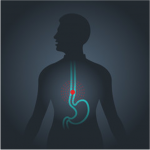April is Esophageal Awareness Month

According to the National Cancer Institute, rates of esophageal cancer and deaths from esophageal cancer have decreased slightly over recent years. Men are about three times more likely than women to develop esophageal cancer. The chance of developing esophageal cancer increases with age. White men develop esophageal cancer at higher rates than Black men in all age groups. In comparison, rates are higher in Black women through 69 years and higher in White women aged 70 years and older. Deaths from esophageal cancer are higher for White men compared with Black men at all ages, while deaths are higher in Black women than in White women.
In the United States, the rates of adenocarcinoma of the esophagus have increased in the last 20 years. It is now more common than squamous cell carcinoma of the esophagus. The rates of squamous cell carcinoma of the esophagus are decreasing, but remain much higher in Black men than in White men.
The esophagus is a muscular tube connecting the throat to the stomach. Esophageal cancer starts in the inside lining of the esophagus and spreads outward through the other layers as it grows.
Scar tissue is another culprit that may not present for 1.5-2 years post-surgery and radiation. Unlike superficial wounds, surgical scar tissue doesn’t just exist on the surface of the body. Scar tissue can extend from the skin all the way down to bones and organs. Sometimes these scars become hard and fibrotic and obstruct lymphatic circulation. Working with a PT or OT who can assist with scar tissue massage and manipulation can be very helpful in preventing the onset of lymphedema and/or minimizing symptoms.
The two most common forms of esophageal cancer are named for the type of cells that become cancerous:
- Squamous cell carcinoma: Cancer that forms in squamous cells, the thin, flat cells lining the esophagus. This cancer is most often found in the upper and middle part of the esophagus but can occur anywhere along the esophagus. This is also called epidermoid carcinoma.
- Adenocarcinoma: Cancer that begins in glandular (secretory) cells. Glandular cells in the lining of the esophagus produce and release fluids such as mucus. Adenocarcinomas usually form in the lower part of the esophagus, near the stomach.
Signs and symptoms of esophageal cancer include:
- painful or difficult swallowing
- weight loss
- pain behind the breastbone
- hoarseness and cough
- indigestion and heartburn
The following can increase a person’s risk of developing esophageal cancer:
- smoking
- heavy alcohol consumption
- Barrett Esophagus
Other risk factors include older age, being male, and being African American.
The following risk factors increase the risk of adenocarcinoma of the esophagus:
Gastric Reflux
Adenocarcinoma of the esophagus is strongly linked to gastroesophageal reflux disease (GERD), especially when the GERD lasts a long time and severe symptoms occur daily. GERD is a condition in which the contents of the stomach, including stomach acid, flow up into the lower part of the esophagus. This irritates the inside of the esophagus, and over time, may affect the cells lining the lower part of the esophagus. This condition is called Barrett esophagus. Over time, the affected cells are replaced with abnormal cells, which may later become adenocarcinoma of the esophagus. Obesity in combination with GERD may further increase the risk of adenocarcinoma of the esophagus.
The use of medicines that relax the lower sphincter muscle of the esophagus may increase the likelihood of developing GERD. When the lower sphincter muscle is relaxed, stomach acid may flow up into the lower part of the esophagus.
It is not known if surgery or other medical treatment to stop gastric reflux lowers the risk of adenocarcinoma of the esophagus. Clinical trials are being done to see if surgery or medical treatments can prevent Barrett esophagus.
The following protective factors may decrease the risk of adenocarcinoma of the esophagus:
Chemoprevention with nonsteroidal anti-inflammatory drugs
Chemoprevention is the use of drugs, vitamins, or other agents to try to reduce the risk of cancer. Nonsteroidal anti-inflammatory drugs (NSAIDs) include aspirin and other drugs that reduce swelling and pain.
Some studies have shown that the use of NSAIDs may lower the risk of adenocarcinoma of the esophagus. However, the use of NSAIDs increases the risk of heart attack, heart failure, stroke, bleeding in the stomach and intestines, and kidney damage.
Radiofrequency ablation of the esophagus
Patients with Barrett esophagus who have abnormal cells in the lower esophagus may be treated with radiofrequency ablation. This procedure uses radio waves to heat and destroy abnormal cells, which may become cancer. Risks of using radiofrequency ablation include narrowing of the esophagus and bleeding in the esophagus, stomach, or intestines.
One study of patients who have Barrett esophagus and abnormal cells in the esophagus compared patients who received radiofrequency ablation with patients who did not. Patients who received radiofrequency ablation were less likely to be diagnosed with esophageal cancer. More study is needed in order to know whether radiofrequency ablation decreases the risk of adenocarcinoma of the esophagus in patients with these conditions.
To learn about safe and effective exercise programming during and after esophageal cancer treatment CLICK HERE
To find a Cancer Exercise Specialist near you CLICK HERE
